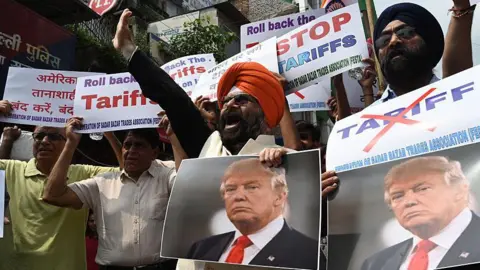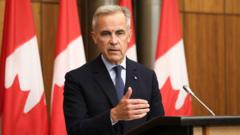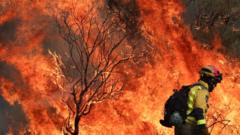In the picturesque vineyards of Burgundy, France, winemakers are grappling with the repercussions of Donald Trump’s tariffs. As the US emerges as their largest export market, these tariffs present a dire challenge, threatening to price esteemed European wines out of American consumers’ reach.
Among the rows of vines, Élodie Bonet is engaged in meticulous pruning, urging the vine to channel its energy into the crucial shoots for the upcoming grape harvest. Nearby, Cécile Tremblay, the owner of Domaine Cécile Tremblay, welcomes visitors into her cellar to sample her exquisite red wines—names like Nuits-Saint-Georges and Chapelle-Chambertin that evoke reverence among wine enthusiasts.
Currently, the stakes are high for Tremblay, who exports more than half of her production, with about 10% heading to the US. Trump's initial threat of a 200% tariff on European alcohol products culminated on April 5, when a 20% tariff was imposed. Following public backlash, this figure was revised to 10% with fears that it could rise again to 20% in the summer, thereby exacerbating worries among winemakers.
François Labet, the Burgundy Wine Board president, underscores the significance of the US market, highlighting that it accounts for roughly a quarter of Burgundy's wine exports. Despite overall declines in French wine exports, Burgundy wines saw a remarkable 16% rise in sales to the US last year, generating substantial revenue. This uptick has been attributed to a growing preference for Burgundy's red wines, made predominantly from pinot noir grapes.
However, winemakers are nervous about repeated tariff hikes. Labet recalls the detrimental 25% tariff from Trump’s first term, which led to a staggering 50% decline in US exports. If the tariffs increase to 20% as threatened, the market could mimic the stagnant conditions of 2019.
Jerome Bauer, of the French National Wines and Spirits Confederation, warns that the current tariff landscape could yield even worse outcomes than before, notably without exemptions for popular wine categories like Champagne. He advocates for favorable trade relations, promoting free trade as the ideal solution.
Surprisingly, the implications are not only felt by French producers; American winemakers also express concern, particularly as trade conflicts affect exports. Rex Stoltz from Napa Valley highlights that tariffs could escalate production costs on components imported from Europe and negatively impact American-governed exports to Canada, which has seen a complete halt in California wine shipments.
Both Burgundy winemakers and their US counterparts are united in their call for a resolution to the trade tensions, hoping to return to a more symbiotic trading relationship that benefits the global wine community.






















